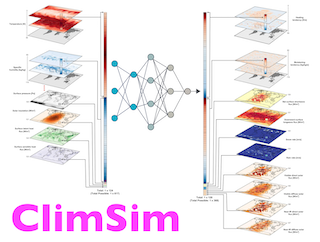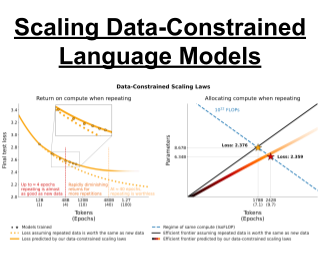|
Test of Time Award
|
Test Of Time
[ Hall E (level 1) ] AbstractThe recently introduced continuous Skip-gram model is an efficient method for learning high-quality distributed vector representations that capture a large number of precise syntactic and semantic word relationships. In this paper we present several improvements that make the Skip-gram model more expressive and enable it to learn higher quality vectors more rapidly. We show that by subsampling frequent words we obtain significant speedup, and also learn higher quality representations as measured by our tasks. We also introduce Negative Sampling, a simplified variant of Noise Contrastive Estimation (NCE) that learns more accurate vectors for frequent words compared to the hierarchical softmax. An inherent limitation of word representations is their indifference to word order and their inability to represent idiomatic phrases. For example, the meanings of Canada'' and "Air'' cannot be easily combined to obtain "Air Canada''. Motivated by this example, we present a simple and efficient method for finding phrases, and show that their vector representations can be accurately learned by the Skip-gram model. |
|
Outstanding Paper
|
Oral Poster
[ Great Hall & Hall B1+B2 (level 1) ] 
AbstractRecent work claims that large language models display \textit{emergent abilities}, abilities not present in smaller-scale models that are present in larger-scale models.What makes emergent abilities intriguing is two-fold: their \textit{sharpness}, transitioning seemingly instantaneously from not present to present, and their \textit{unpredictability}, appearing at seemingly unforeseeable model scales.Here, we present an alternative explanation for emergent abilities: that for a particular task and model family, when analyzing fixed model outputs, emergent abilities appear due the researcher’s choice of metric rather than due to fundamental changes in model behavior with scale. Specifically, nonlinear or discontinuous metrics produce apparent emergent abilities, whereas linear or continuous metrics produce smooth, continuous, predictable changes in model performance.We present our alternative explanation in a simple mathematical model, then test it in three complementary ways: we (1) make, test and confirm three predictions on the effect of metric choice using the InstructGPT/GPT-3 family on tasks with claimed emergent abilities, (2) make, test and confirm two predictions about metric choices in a meta-analysis of emergent abilities on BIG-Bench; and (3) show how to choose metrics to produce never-before-seen seemingly emergent abilities in multiple vision tasks across diverse deep networks.Via all three analyses, we provide evidence that alleged emergent abilities evaporate … |
|
Outstanding Paper
|
Poster
[ Great Hall & Hall B1+B2 (level 1) ] 
AbstractGenerative Pre-trained Transformer (GPT) models have exhibited exciting progress in capabilities, capturing the interest of practitioners and the public alike. Yet, while the literature on the trustworthiness of GPT models remains limited, practitioners have proposed employing capable GPT models for sensitive applications to healthcare and finance – where mistakes can be costly. To this end, this work proposes a comprehensive trustworthiness evaluation for large language models with a focus on GPT-4 and GPT-3.5, considering diverse perspectives – including toxicity, stereotype bias, adversarial robustness, out-of-distribution robustness, robustness on adversarial demonstrations, privacy, machine ethics, and fairness. Based on our evaluations, we discover previously unpublished vulnerabilities to trustworthiness threats. For instance, we find that GPT models can be easily misled to generate toxic and biased outputs and leak private information in both training data and conversation history. We also find that although GPT-4 is usually more trustworthy than GPT-3.5 on standard benchmarks, GPT-4 is more vulnerable given jailbreaking system or user prompts, potentially due to the reason that GPT-4 follows the (misleading) instructions more precisely. Our work illustrates a comprehensive trustworthiness evaluation of GPT models and sheds light on the trustworthiness gaps. Our benchmark is publicly available at https://decodingtrust.github.io/. |
|
Outstanding Paper
|
Poster
[ Great Hall & Hall B1+B2 (level 1) ] 
AbstractModern climate projections lack adequate spatial and temporal resolution due to computational constraints. A consequence is inaccurate and imprecise predictions of critical processes such as storms. Hybrid methods that combine physics with machine learning (ML) have introduced a new generation of higher fidelity climate simulators that can sidestep Moore's Law by outsourcing compute-hungry, short, high-resolution simulations to ML emulators. However, this hybrid ML-physics simulation approach requires domain-specific treatment and has been inaccessible to ML experts because of lack of training data and relevant, easy-to-use workflows. We present ClimSim, the largest-ever dataset designed for hybrid ML-physics research. It comprises multi-scale climate simulations, developed by a consortium of climate scientists and ML researchers. It consists of 5.7 billion pairs of multivariate input and output vectors that isolate the influence of locally-nested, high-resolution, high-fidelity physics on a host climate simulator's macro-scale physical state.The dataset is global in coverage, spans multiple years at high sampling frequency, and is designed such that resulting emulators are compatible with downstream coupling into operational climate simulators. We implement a range of deterministic and stochastic regression baselines to highlight the ML challenges and their scoring. The data (https://huggingface.co/datasets/LEAP/ClimSim_high-res) and code (https://leap-stc.github.io/ClimSim) are released openly to support the development of … |
|
Outstanding Paper
|
Oral Poster
[ Great Hall & Hall B1+B2 (level 1) ] 
AbstractWe propose a scheme for auditing differentially private machine learning systems with a single training run. This exploits the parallelism of being able to add or remove multiple training examples independently. We analyze this using the connection between differential privacy and statistical generalization, which avoids the cost of group privacy. Our auditing scheme requires minimal assumptions about the algorithm and can be applied in the black-box or white-box setting. We demonstrate the effectiveness of our framework by applying it to DP-SGD, where we can achieve meaningful empirical privacy lower bounds by training only one model. In contrast, standard methods would require training hundreds of models. |
|
Outstanding Paper Runner-up
|
Oral Poster
[ Great Hall & Hall B1+B2 (level 1) ] 
AbstractWhile large-scale unsupervised language models (LMs) learn broad world knowledge and some reasoning skills, achieving precise control of their behavior is difficult due to the completely unsupervised nature of their training. Existing methods for gaining such steerability collect human labels of the relative quality of model generations and fine-tune the unsupervised LM to align with these preferences, often with reinforcement learning from human feedback (RLHF). However, RLHF is a complex and often unstable procedure, first fitting a reward model that reflects the human preferences, and then fine-tuning the large unsupervised LM using reinforcement learning to maximize this estimated reward without drifting too far from the original model. In this paper, we leverage a mapping between reward functions and optimal policies to show that this constrained reward maximization problem can be optimized exactly with a single stage of policy training, essentially solving a classification problem on the human preference data. The resulting algorithm, which we call Direct Preference Optimization (DPO), is stable, performant, and computationally lightweight, eliminating the need for fitting a reward model, sampling from the LM during fine-tuning, or performing significant hyperparameter tuning. Our experiments show that DPO can fine-tune LMs to align with human preferences as well as … |
|
Outstanding Paper Runner-up
|
Oral Poster
[ Great Hall & Hall B1+B2 (level 1) ] 
AbstractThe current trend of scaling language models involves increasing both parameter count and training dataset size. Extrapolating this trend suggests that training dataset size may soon be limited by the amount of text data available on the internet. Motivated by this limit, we investigate scaling language models in data-constrained regimes. Specifically, we run a large set of experiments varying the extent of data repetition and compute budget, ranging up to 900 billion training tokens and 9 billion parameter models. We find that with constrained data for a fixed compute budget, training with up to 4 epochs of repeated data yields negligible changes to loss compared to having unique data. However, with more repetition, the value of adding compute eventually decays to zero. We propose and empirically validate a scaling law for compute optimality that accounts for the decreasing value of repeated tokens and excess parameters. Finally, we experiment with approaches mitigating data scarcity, including augmenting the training dataset with code data or removing commonly used filters. Models and datasets from our 400 training runs are freely available at https://github.com/huggingface/datablations. |